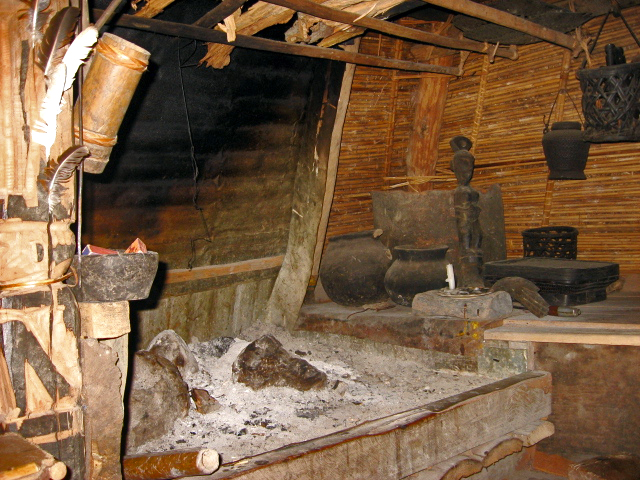 |
| Ifugao's home sweet home. |
Since I have been sharing my experiences in Batad, I will take this opportunity to tell you how I felt during my short stay in an Ifugao hut. The Ifugao hut is the primordial dwelling place of the Ifugao people, the pyramidal hut was built with simplicity and its architecture was uniquely made with no nails and bolts used. It can also withstand strong earthquakes, typhoons and torrential rains. The thatched huts with walls made from bamboo and woods can accommodate a big family. There were 5 of us and there's still room for more. Ramon, the owner of the hut is always willing to accommodate guests in order to let tourists experience and know the ingenuity of Ifugao.
The bent wood on the door if you will notice serves as a holding device when climbing the ladder, which I think is very useful for tourists whose having a hard time climbing the ladder like me. There are some tools for farming and a "salakot"(native hat) and raincoat made from indigenous materials hanged on its ceiling. The cogon grass ceiling which were laid tightly to each other, can surely provide natural ventilation during hot climate while maintaining warmth during cold and rainy seasons.
On the exterior side of the hut were skulls of animals which were butchered during feasts and rituals. There were several of them displayed as adornments and to show the family's social status. I felt awkward when thoughts came that I will be sleeping in a hut with all those skulls around it, but if it shows wealth, then it's a privilege to belong to a wealthy Ifugao clan just for a night! And why not?
I roamed around beneath the hut and saw old things which I thought used for cooking. As I see it, the lower level of the house serves as the receiving area for visitors, a recreational area and a place for household works. The "daulon" is how they call it, is a cool place to have a hot cup of coffee, with family or friends and tell stories about nature and folklore, like what we did. Dusted native poultry cages stands near some old earthenware jars and cooking utensils, which was done with artistry, simplicity and originality are some of the things found, and are still of great value.
Its ladder is detachable so it can be pulled up inside the house for the safety of the occupants. Honestly, I had a hard time climbing the ladder because it hurts my feet and that I only went up to the hut if needed. I just threw my bags and other things to make it easier for me and just to avoid the ladder.
The main room was spacious and there was an attic where it could accommodate more occupants. I can't believe that it also has a small fireplace in a corner where they can cook and at the same time can provide warmth in the room. Ashes were scattered that it brought my imagination back to the early times when the former dwellers of this hut were already contented with what they had. The candle standing on a thick slab of wood provided a soft light making the room cozy.
It was really dark in there, even during daytime, the small hole which serves as ventilation aside from the door gives a favorable temperature to the occupants. I peeked through the hole and I saw an expanse of greenery which gave life to the darkness of the room.
When nature calls, the toilet and bathroom are just beside the hut and the cliff. It was a funny and odd experience for me to take a bath in a bathroom where my upper body was exposed to nature. Well, the good thing was the tin walls are tall enough to cover my lower torso, there is no heater so I have to face the ice bucket challenge, the water was so freezing and I was shouting and shivering that time but I was refreshed after a day of walking. The best way to take a bath is to wait for the sundown and crouch but I am telling you, the water was still cold.
The traditional Ifugao hut has undergone a lot of rituals, traditions and beliefs before they were constructed. It has a soul, knowing that all parts of it were taken from God's creation. The roofs, the walls, the beams, fireplace and ladder, all of them were made from the hands of the people's creativeness, feelings, thoughts, values, fears and aspirations in which our ancestors has lived harmoniously and comfortably no matter how peculiar they are to others.
Thank you for reading!







